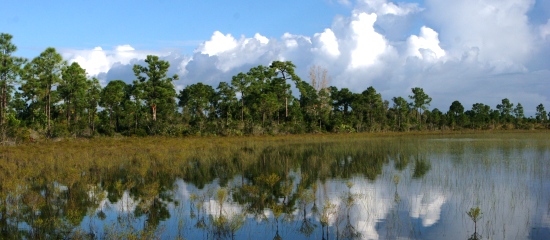 Back to Natural Areas List
Back to Natural Areas List
Loxahatchee Slough
North and south of PGA Boulevard, approximately 2.2 miles west of Florida's Turnpike, Palm Beach Gardens

Palm Beach County's Largest and Most Biologically Diverse Natural Area
Open Sunrise to Sunset, 365 Days a Year
At a Glance
Headwaters of the Loxahatchee Wild and Scenic River
Nine native Florida ecosystems are preserved at this 13,025-acre site: mesic flatwoods, wet flatwoods, mesic hammock, hydric hammock, wet prairie, depression marsh, slough marsh, strand swamp, and dome swamp. During the summer and fall this site gets very wet for hiking so bring your mud boots or stay on the multiuse trails to stay high and dry along the perimeter of the site.
The natural area is accessible at the following locations:
Main Entrance
11855 Beeline Highway, Palm Beach Gardens









Large parking area, informational kiosks, paved hiking trail, accessible covered observation platform, accessible restrooms, natural surface hiking trails that lead to a fishing pier and observation tower, and portions of the
Ocean to Lake Hiking Trail.
Karen T. Marcus Sandhill Crane Access Park
8175 PGA Boulevard, Palm Beach Gardens








Parking area, observation tower, restrooms with access to the Jeaga Wildways multiuse trail that traverses the eastern edge of the natural area along an improved berm on the east side of the C-18 Canal. This trail is paved south and improved with shell rock to the north of PGA Boulevard.
Kayak & Canoe Launch
8311 PGA Boulevard, Palm Beach Gardens




Parking area and launch that leads paddlers on a 2 mile kayak trail (one-way) through the natural area on the west side of the C-18 Canal. Paddlers are allowed to catch and release fish along the trail.
Riverbend Park
9060 Indiantown Road, Jupiter





Access the natural area from the southeastern portion of Riverbend Park along two long-distance multiuse
Jeaga Wildways trails. On the west side of the C-18 Canal follow the multiuse trail west through northern sections of the natural area.
NOTE: Biking is only allowed on the multiuse trail. Equestrian only and hiking only trails break off the multiuse trail in this section. Follow the signs for proper trail usage. On the east side of the C-18 Canal follow another long-distance multiuse trail south.
Photos
 FLICKR ALBUM
FLICKR ALBUM
Trail Rules
A blanket permit has been issued for equestrians and cyclists to utilize designated portions of this site according to the following rules:
1. Equestrian and bicycle use of this natural area is authorized by a general permit and designation of specific bicycle access routes. All users must comply with these rules, the provisions of Chapter 11, Article XI of the Palm Beach County Code, and the rules posted on the natural area's signs and informational kiosks.
2. Equestrians and cyclists must stay on the designated multiuse trails. Lands adjacent to the trails are environmentally sensitive and can easily be damaged.
3. Do not tie or hitch horses or bicycles to trees or shrubs. If you wish to hike on the natural area, use horse hitches and bike racks at trailheads.
4. Do not allow horses to graze on or otherwise damage vegetation.
5. Ride at your own risk. Riding helmets are recommended. Helmets are mandatory for riders under the age of 16. See Florida Statutes, Section 773.06 (for equestrians) and Section 316.2065 (for cyclists).
6. Horses and bicycles must be under control at all times. No galloping, running, racing, or trick riding.
7.
Cyclists must yield right of way to equestrians:
• Announce yourself as soon as you are within hearing distance.
• Ask the equestrian rider how to proceed without startling the horse.
• Keep talking- your voice will distinguish you from a predator.
8. Equestrians must walk their horses when approaching or passing others. If riding abreast, one rider must yield to the approaching or passing rider.
9. Horses known to kick must wear red ribbons in their tails.
10. Riders must carry proof of a negative Coggins test and present it upon request.